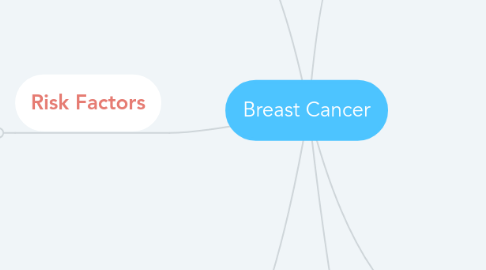
1. SYMPTOMS
1.1. New lump in the breast or underarm (armpit
1.1.1. Thickening or swelling of part of the breast.
1.1.1.1. Irritation or dimpling of breast skin.
1.1.1.1.1. Redness or flaky skin in the nipple area or the breast
1.2. Nipple discharge other than breast milk, including blood
1.2.1. Any change in the size or the shape of the breast
1.2.1.1. Pain in any area of the breast.
2. Risk Factors
2.1. Getting older.
2.1.1. Starting menopause after age 55.
2.1.1.1. Using combination hormone therapy.
2.2. Genetic mutations.
2.2.1. Not being physically active.
2.2.1.1. Taking oral contraceptives (birth control pills).
2.3. Early menstrual period
2.3.1. Being overweight or obese after menopause
2.3.1.1. Family history of breast cancer
2.4. Late or no pregnancy.
2.4.1. Having dense breasts
2.4.1.1. Previous treatment using radiation therapy.
3. Diagnostic
3.1. Breast exam
3.2. Imaging tests
3.2.1. mammogram
3.2.1.1. ultrasound scan
3.2.1.1.1. MRI scan
3.3. Biopsy
4. Pathophysiology
4.1. Breast cancer is a malignant tumor that starts in the cells of the breast. Like other cancers, there are several factors that can raise the risk of getting breast cancer. Damage to the DNA and genetic mutations can lead to breast cancer have been experimentally linked to estrogen exposure. Some individuals inherit defects in the DNA and genes like the BRCA1, BRCA2 and P53 among others.
4.2. The immune system normally seeks out cancer cells and cells with damaged DNA and destroys them. Breast cancer may be a result of failure of such an effective immune defence and surveillance.
5. Treatment
5.1. radiation therapy
5.2. surgery
5.3. biological therapy, or targeted drug therapy
5.4. hormone therapy
5.5. chemotherapy
6. Immunity
6.1. The concept that the immune system regulates cancer development is experiencing a new era of interest. It is clear that the cancer immunosurveillance process indeed exists and potentially acts as an extrinsic tumor suppressor.
6.1.1. The immune system can facilitate tumor progression by sculpting the immunogenic phenotype of tumors as they develop. Cancer immunoediting represents a refinement of the cancer immunosurveillance hypothesis and resumes the complex interaction between tumor and immune system into three phases: elimination, equilibrium, and escape.
6.1.2. The immune system plays a dual role in cancer: it not only can suppress tumor growth by destroying cancer cells or inhibiting their outgrowth but also promotes tumor progression either by selecting for tumor cells that are more fit to survive in an immunocompetent host or by establishing conditions within the tumor microenvironment that facilitate tumor outgrowth.

